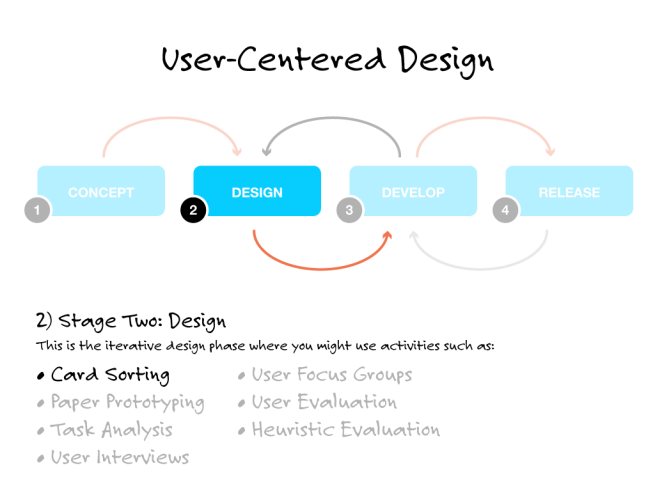WEB204 » Conducting a Card Sort for Your Website Information Architecture
Creating an Information Architecture for your Website that a user can follow an easy path to the information they seek is absolutely essential for you business to succeed. According to the Information Architecture Institute, Information Architecture is defined as the art and science of organizing and labeling web sites, intranets, online communities and software to support usability and findability.
But… how do we know how to design and present our Information Architecture using 1) meaningful groups of information, 2) a functional sequence between groups of information and 3) a clear and concise naming convention for labeling categories?
Card Sorting, of course!
What is a Card Sort?
According to Courage & Baxter, Card Sorting is a popular and inexpensive user-centered research methodology that allows the researcher to collect data from website user groups in terms of how information on a website should be grouped, organized and labeled according to the user’s mental model.
To conduct a card sort the researcher prepares a set of cards that contain a title and a brief description of the pieces of information or tasks that are or are proposed to be in the informational structure of a website.
See Also:
- Usability Card Sorting for Website | Intellavia
- Card Sorting | Usability.gov
- Using Card Sorting To Test Information Architecture | Measuring Usability
- Improving Your Information Architecture With Card Sorting: A Beginner’s Guide | Smashing Magazine
- Card Sorting: a Definitive Guide | Boxes & Arrows
Why Should we Conduct a Card Sort?
According to Croft, “It’s not difficult to end up with a badly organized website, despite one’s best intentions. But how does a website end up like this in the first place? One of the most common reasons is that the IA is created from the business structure of the organization, rather than from users’ needs.”
Therefore, according to Courage & Baxter, a Card Sort can help identify:
- Overall organization of the content or tasks in your product
- Terminology employed by users
- Labels users apply to different categories of information or tasks
- Missing and unnecessary objects
When Should we Conduct a Card Sort?
A Card Sort typically gets performed when a website is undergoing a design or re-design. It is incredibly helpful to have users give your feedback on how to present our Information Architecture using 1) meaningful groups of information, 2) a functional sequence between groups of information and 3) a clear and concise naming convention for labeling categories.
How Do we Conduct a Card Sort?
To conduct this a card sort study, an inventory needs to be first taken of the entire website. These items then end up being the “Cards” to be “Sorted” and analyzed for your Information Architecture
1) Identify Objects & Definitions for Sorting
According to Usability.gov, to prepare your cards, you should create your list of content topics. Topics can be phrases or words, very specific or more general. As a suggestion, limit yourself to 50-60 topics or less. This means there might not be a card to sort for every page on the site.
For a website, your will need to audit the existing architecture of our website and list out our destination pages (objects) and the topics and tasks (definitions) that they cover:
2) Running the Study with Participants
A card sort can be run using just a set of index cards and a table. But, if you’re cool, the card sort can be conducted online using WebSort now Optimal Sort owned by Optimal Workshop.
According to Tullis & Wood, a card sort with only 20 to 30 participants can yield an average correlation coefficient well over 0.9. For best results, you should choose to run your study with participants that fall within your demographics. According to Courage & Baxter, running one or two group sessions with 10 to 12 participants of the same user type should be sufficient.
Once you have selected your participants, you can simply invite them via email to take part in your study!
First, introduce the participants and explain the study that you are conducting:
Then, have your participants group the cards and label their groupings as they see fit:
3) Data Analysis & Interpretation
Here comes the hard part… This is where we will need to make sense out of our data.
To analyze the data from the study, you should start by analyzing the card groupings by user group for similarities and differences between user groups. According to Courage & Baxter, it is advised to analyze user groups separately since each group might have very different needs. Analyzing all the user groups together without first inspecting the differences between them could lead to an “averaged” user experience between each group that isn’t actually useful to any of the groups.
Here is where we can see what labels the participants used for categories:
We can then look at the Tree Graphs for grouping trends across each demographic group:
You can even go old school with the Tree Graphs by printing them out (for each demographic) and grabbing your sharpie:
You can also look for groupings using the Similarity Matrix:
Timelapse: Card sort – similarity matrix analysis from rebecca destello on Vimeo.
See Also:
- Card Sorting the Human Centered Design & Engineering Website Information Architecture | Mike Sinkula
- Card Sorting: How Many Users to Test | Nielsen Norman Group
- Usability Testing for the 1995 Sun Microsystems’ Website | Nielsen Norman Group
- How Many Users Are Enough for a Card-Sorting Study? | Tullis & Wood
4) Conclusions & Recommendations
Lastly, you will need to to conclude your study and make your recommendations. This is where you will use the data to propose a new information architecture.
We should also remember that when conducting a card sort study, it is important to accept that groupings across all user groups should be used as a guide, and adjustments should be made as needed, based on judgement.
This is where you should present the data to the stakeholder and finalize your recommended information architecture:
Your website should be much more usable once you implement this new information architecture. ;-)
Demos:
- W16: https://q8l51tfe.optimalworkshop.com/optimalsort/itc298w16
- Sp16: https://q8l51tfe.optimalworkshop.com/optimalsort/ky7rx02j
- W17: https://q8l51tfe.optimalworkshop.com/optimalsort/283d3i2t
This portion of the Premium Design Works website is written by Mike Sinkula for the Web Design & Development students at Seattle Central College and the Human Centered Design & Engineering students at the University of Washington.




















Social